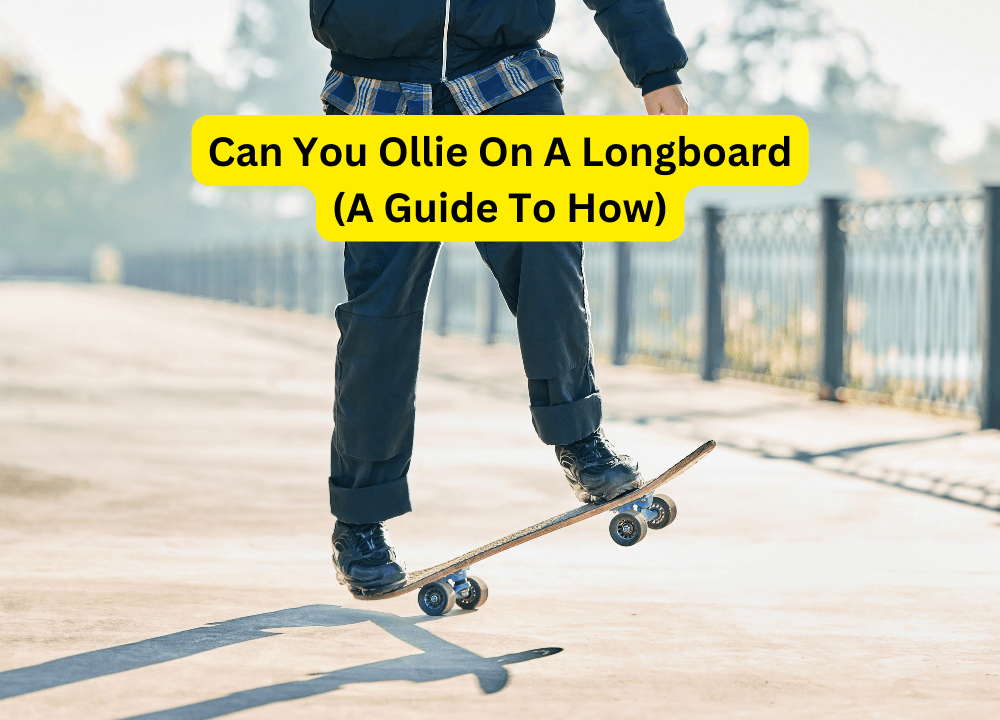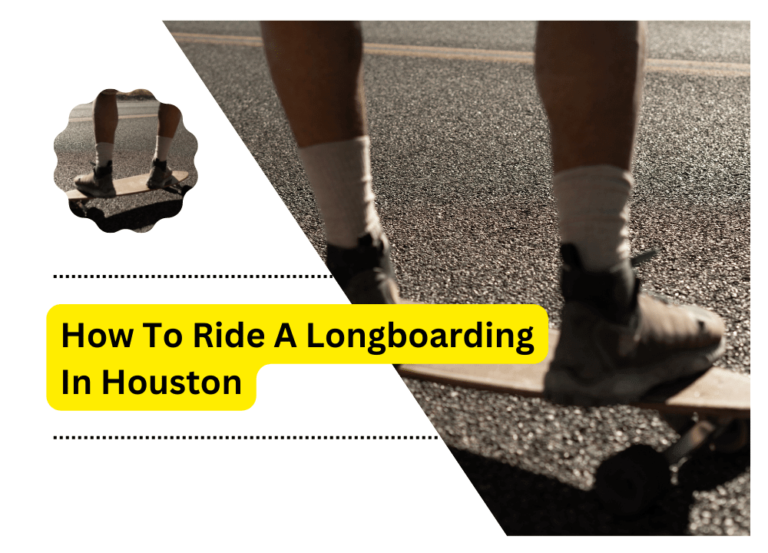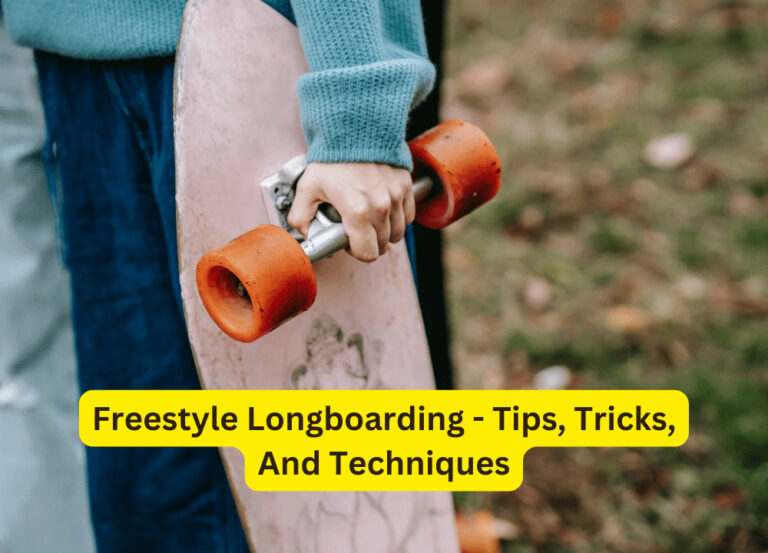Can You Ollie On A Longboard (A Guide To How)

Ollie is one of the common and fundamental tricks of skateboarding. Being a longboard user or just shifting to it from a skateboard, a common question always arises can you ollie on a longboard? Yes, you can ollie on a longboard and several other tricks.
Longboard ollie is more complicated than skateboard ollie because it is designed to cover longer distances and stability not for it..
Ollie is the longboard and skateboard trick in which the rider jumps into the air without the help of a ramp or the rider’s hands. For the longboard, Ollie positioned one foot in the middle. With your back foot, push off the ground and raise the board’s tail. As you pop off, execute a jump while simultaneously grabbing onto the board before it descends.
.
Why Ollie Trick On a Longboard is Difficult
It isn’t easy to perform Ollie on a longboard as compared to a skateboard due to the following reasons
Lack Of Concave
It is difficult to perform the ollie trick on the longboard as it is long in size and does not have a concave side like a skateboard.it is something that makes skateboarding difficult for the beginner on the longboard
Soft, Bouncy Wheel
The major difference is that the longboard wheel is soft, which bounces a lot and gives sketchy landing results. The board can also bounce, resulting in injury.
Lack Of Kicktail
Longboards lack the firm kicktail, making it difficult to pop up the longboard compared to a skateboard. But being skilled becomes easier for you.
How To Ollie On a Longboard In a Smart Way
It’s difficult to perform Ollie on a longboard, but by following these steps, we are sure you can master it.
Step 1: Acknowledgment and Preparation
Before embarking on your ollie journey, it is essential to acknowledge that performing this trick on a longboard is challenging compared to a skateboard. Longboards have a longer and wider deck, making the Ollie slightly more complex.
You may fail and fall during this, and injuries are expected. Begin by familiarizing yourself with the basic principles of the Ollie.
Understands that achieving results requires practice, patience, and determination.
Step 2: Learn About Longboard Anatomy
Understanding the anatomy of a longboard before diving or executing Ollie is crucial. This knowledge will help you better grasp the mechanics of the trick. longboard consists of the following components
- Deck
- Trucks
- wheels
Deck
The deck is a flat platform longer and wider than a skateboard to stand on. Riders must select a longboard deck that suits their riding style, skill level, and personal preferences. Factors such as deck length, width, shape, flex, and concave should all be considered when choosing a longboard deck to enhance the overall longboarding experience.
Ensure it has a tail (back) and nose (front end).
- For Ollie, choose a deck
- wider kick with the raised end of the deck.
- consider a cave deck instead of a concave for better performance in the air.
- Prefer flexible decks for a smoother, surf-like feel,
- Prefer firm decks offering more control and stability.
Truck
Longboard trucks are the metal components that connect the wheels to the board present below the deck. They consist of a baseplate, hanger, axle, kingpin, bushings, and pivot cup. Trucks provide stability, facilitate turning, and absorb vibrations. Choosing the right trucks is vital for optimal performance.
- Wider trucks offer stability
- narrower ones provide good maneuverability
- Softer bushings enable easier turning
- harder bushing offers stability at high speeds.
Experimenting with different setups and adjustments helps you find the right one.
Wheel
Longboard has the softer and bouncy wheel
Step 3:Step Up On The Board
We recommend you to familiarize yourself with your longboard before stepping into ollies. pay close attention to a few details: balance, stability, and control.
Consider things like how wide the deck is. Its flexibility does it jiggle a lot? And its truck, is it tight enough to give you the freedom to move freely?
You need to choose a longboard on which you feel comfortable otherwise you will not be able to perform ollie with it. Because the finest and most expensive ones become a waste when you are uncomfortable with them. You must be familiar with how it feels and works. Choose the one that gives you a natural feel, like your second pair of feet.
Step 4: Position The Foot
Proper foot position is crucial for executing a successful ollie on a longboard.
- The front foot should be near the center of the deck
- The back foot rests on the rear tail or kick.
- The ball of the front foot aligns with the deck’s center
- The ball of the back foot hangs half off the edge.
Practice is crucial to mastering these positions. Deviating from these guidelines can affect the outcome of the Ollie, with wider foot spacing resulting in a more intense jump.
However, it requires stability and experience.
Beginners may not need to space their feet too wide. Ultimately, the key to a successful Ollie lies in the positioning and technique of the feet.
Step 5: Upper Body Motion.
The upper body plays a vital role and is as important as the feet in doing the ollie trick on a longboard. After placing your feet in the right position, it’s time to position your upper body for this.
- Keep your shoulders and torso aligned with the board as you initiate the trick.
- Bend your knees slightly and prepare to crouch,
- generating power and pressure on deck with your feet.
- Don’t bend and crouch too much
- The knees need to be bent at a 90-degree angle.
- Don’t overdo the crouch. Keep your motion natural and light.
- Stay on your ball of the foot while crouching.
- Keep your shoulder level with your feet.
After positioning your upper body, relax and don’t panic or be nervous. Keep your body loose.
Just build the pressure on the legs nowhere else.
Step 6: Jump
With proper feet position and upper body properly aligned, it’s time to execute the Ollie. It advises avoiding jumping with both feet simultaneously. As its results in losing potential energy and landing too hard. Instead, the key is to jump one foot at a time. The front foot jumps first, followed by the back foot. While the front foot is in the air, it should brush against the front kick. Simultaneously, the back foot forces down the rear kick, creating a “pop” sound as it hits the ground. This motion causes the front kick to flip up while the front foot brushes against the front tail. This sequence of movements is crucial for executing a successful Ollie.
Step 7: Landing
Maintain a bent leg position during the airborne phase to absorb impact upon landing, and subsequently return your feet to the board once it touches the ground with its wheels.
Step 8: Practice
Learning to Ollie on a longboard is tough as compared to skateboarding. Its requires practice and consistency. There are high chances of injuries so use the knee pad, elbow pad, and helmet during practice. Start by attempting small, controlled ollies and gradually work to higher and longer jumps. Be patient. Keep practicing even if progress is slow. Repetition and persistence are key factors in mastering this trick.






